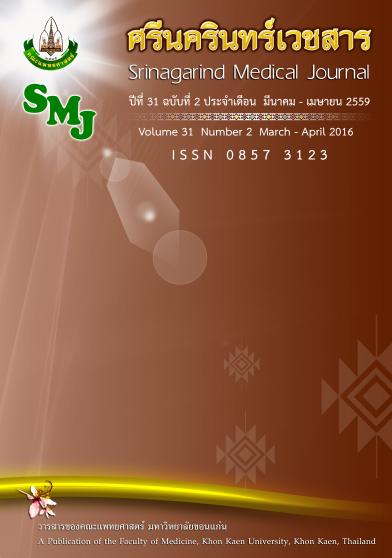Median Survival and Prognostic Factors in Diffuse Large B cell Lymphoma Patients
คำสำคัญ:
diffuse large B cell lymphoma, lymphoma, prognosisบทคัดย่อ
Background and objective: Diffuse large B cell lymphoma (DLBCL) is an aggressive type of lymphoma and commonly found worldwide including Thailand. The aims of this study are to determine median survival (MS) of all stages of lymphoma patients aging 20-80 years old and analyse prognostic factors age, gender, stages of disease, Eastern Cooperative Oncology Group (ECOG), serum levels of lactate dehydrogenase (LD) and extra-nodal site.
Methods: A retrospective study was performed and new cases with diagnosis of DLBCL from January 2010 to December 2014 (70 patients) in Ubonratchathani Cancer Hospital (a 250 bed hospital) were enrolled. All patients had undergone surgical biopsy with pathological report of DLBCL. The classification of DLBCL is based on WHO classification of tumors of hematopoietic and lymphoid tissue 2008 and it is classified into low risk, low intermediate risk, high intermediate risk and high risk. The prognostic factors were determined by using univariate and multivariate analysis and hazard ratio (HR) was presented. Median survival was analysed by using Kaplan-Meier curve
Results: The median survival time of low risk group was 55.8 months (95% CI: 54.4-57.1), low intermediate risk group was 41.2 months (95%CI:39.7-42.6), high intermediate risk group was 38.1 months (95% CI:28.8-47.3), high risk group was 15.7 months (95%CI:4.8-41.3) with P value of 0.001. Lymphoma patients with age > 61 years (HR=2.341), stage 3-4 of disease (HR=2.835), ECOG 2-3 (HR=4.258) and LDL levels ≥ 247 U/L (HR=5.145) significantly correlate with median survival time in DLBCL group (p value was <0.001).
Conclusion : Median survival time of lymphoma patients with DLBCL significantly depends on the classification of risk group of disease. Age, stages of disease, ECOG and level of LDH influences on the prognosis of disease.




